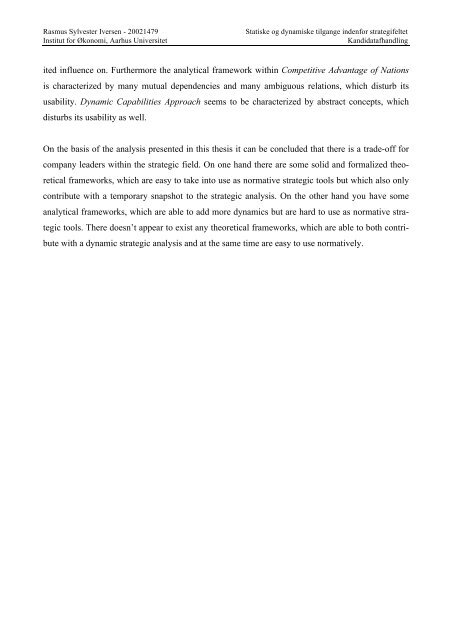Statiske og dynamiske tilgange indenfor strategifeltet - Aarhus ...
Statiske og dynamiske tilgange indenfor strategifeltet - Aarhus ... Statiske og dynamiske tilgange indenfor strategifeltet - Aarhus ...
Rasmus Sylvester Iversen - 20021479 Institut for Økonomi, Aarhus Universitet Statiske og dynamiske tilgange indenfor strategifeltet Kandidatafhandling Abstract The strategic industry perspective presented by M.E. Porter, in his book Competitive Strategy as well as “The Resource Based View of the Firm”, have in many years been the dominating paradigms in the strategic management field. The reason for this being that they both give some relatively formalized analytical frameworks, which are fairly straightforward to use normatively. However both paradigms have also been criticized of being too static. The main purpose of this thesis is to analyze to which extent it has been possible within these two paradigms to add more dynamic thinking. This has been done by considering whether the theories, Competitive Advantage of Nations and Dynamic Capabilities Approach, considered in this thesis as the dynamic “superstructures” within the two paradigms, have succeeded in adding more dynamics to respectively the Competitive Strategy and The Resource Based View of the Firm. In addition to this it has been analyzed whether there are any complications concerned with using the dynamic “superstructures” as a normative strategic tool. The primary weakness of the two dominating paradigms appears to be that their analytical frameworks merely contribute with a static snapshot explaining only, which sources represent a competitive advantage at any given point in time. The reason for these static approaches is that both paradigms have their roots in microeconomics. The thesis illustrates that Competitive Advantage of Nations and Dynamic Capabilites Approach are able to add more dynamics as they focus on the dynamic process through which a competitive advantage is achieved and developed. The primary reason for this being that the dynamic “superstructures”, instead of having their roots in the microeconomic equilibrium foundation, are inspired by more development focussed approaches like the Austrian school of economics and evolutionary theories. However despite the fact that these dynamic ”superstructures” are able to add more dynamics to the two paradigms their normative usability can still be criticized. For instance because the strategic suggestions that both theories come up with are based on elements that the company has only lim-
Rasmus Sylvester Iversen - 20021479 Institut for Økonomi, Aarhus Universitet Statiske og dynamiske tilgange indenfor strategifeltet Kandidatafhandling ited influence on. Furthermore the analytical framework within Competitive Advantage of Nations is characterized by many mutual dependencies and many ambiguous relations, which disturb its usability. Dynamic Capabilities Approach seems to be characterized by abstract concepts, which disturbs its usability as well. On the basis of the analysis presented in this thesis it can be concluded that there is a trade-off for company leaders within the strategic field. On one hand there are some solid and formalized theoretical frameworks, which are easy to take into use as normative strategic tools but which also only contribute with a temporary snapshot to the strategic analysis. On the other hand you have some analytical frameworks, which are able to add more dynamics but are hard to use as normative strategic tools. There doesn’t appear to exist any theoretical frameworks, which are able to both contribute with a dynamic strategic analysis and at the same time are easy to use normatively.
- Page 1: Statiske og dynamiske tilgange inde
- Page 5 and 6: Rasmus Sylvester Iversen - 20021479
- Page 7 and 8: Rasmus Sylvester Iversen - 20021479
- Page 9 and 10: Rasmus Sylvester Iversen - 20021479
- Page 11 and 12: Rasmus Sylvester Iversen - 20021479
- Page 13 and 14: Rasmus Sylvester Iversen - 20021479
- Page 15 and 16: Rasmus Sylvester Iversen - 20021479
- Page 17 and 18: Rasmus Sylvester Iversen - 20021479
- Page 19 and 20: Rasmus Sylvester Iversen - 20021479
- Page 21 and 22: Rasmus Sylvester Iversen - 20021479
- Page 23 and 24: Rasmus Sylvester Iversen - 20021479
- Page 25 and 26: Rasmus Sylvester Iversen - 20021479
- Page 27 and 28: Rasmus Sylvester Iversen - 20021479
- Page 29 and 30: Rasmus Sylvester Iversen - 20021479
- Page 31 and 32: Rasmus Sylvester Iversen - 20021479
- Page 33 and 34: Rasmus Sylvester Iversen - 20021479
- Page 35 and 36: Rasmus Sylvester Iversen - 20021479
- Page 37 and 38: Rasmus Sylvester Iversen - 20021479
- Page 39 and 40: Rasmus Sylvester Iversen - 20021479
- Page 41 and 42: Rasmus Sylvester Iversen - 20021479
- Page 43 and 44: Rasmus Sylvester Iversen - 20021479
- Page 45 and 46: Rasmus Sylvester Iversen - 20021479
- Page 47 and 48: Rasmus Sylvester Iversen - 20021479
- Page 49 and 50: Rasmus Sylvester Iversen - 20021479
- Page 51 and 52: Rasmus Sylvester Iversen - 20021479
Rasmus Sylvester Iversen - 20021479<br />
Institut for Økonomi, <strong>Aarhus</strong> Universitet<br />
<strong>Statiske</strong> <strong>og</strong> <strong>dynamiske</strong> <strong>tilgange</strong> <strong>indenfor</strong> <strong>strategifeltet</strong><br />
Kandidatafhandling<br />
ited influence on. Furthermore the analytical framework within Competitive Advantage of Nations<br />
is characterized by many mutual dependencies and many ambiguous relations, which disturb its<br />
usability. Dynamic Capabilities Approach seems to be characterized by abstract concepts, which<br />
disturbs its usability as well.<br />
On the basis of the analysis presented in this thesis it can be concluded that there is a trade-off for<br />
company leaders within the strategic field. On one hand there are some solid and formalized theoretical<br />
frameworks, which are easy to take into use as normative strategic tools but which also only<br />
contribute with a temporary snapshot to the strategic analysis. On the other hand you have some<br />
analytical frameworks, which are able to add more dynamics but are hard to use as normative strategic<br />
tools. There doesn’t appear to exist any theoretical frameworks, which are able to both contribute<br />
with a dynamic strategic analysis and at the same time are easy to use normatively.



